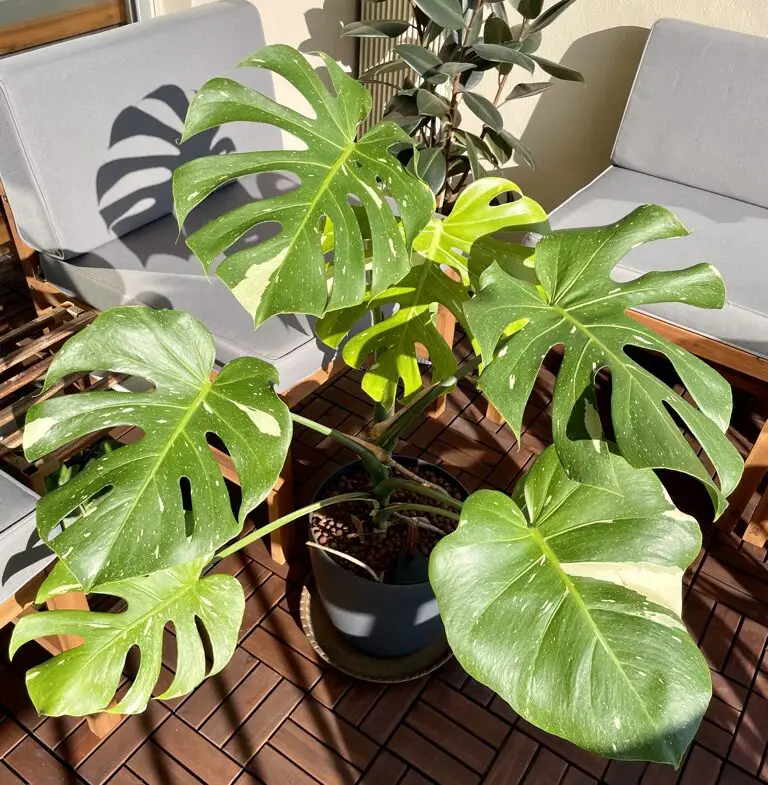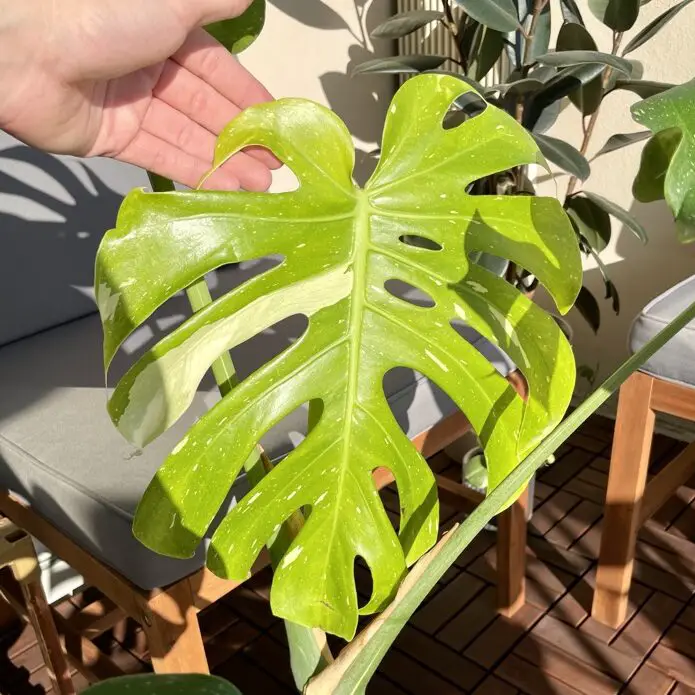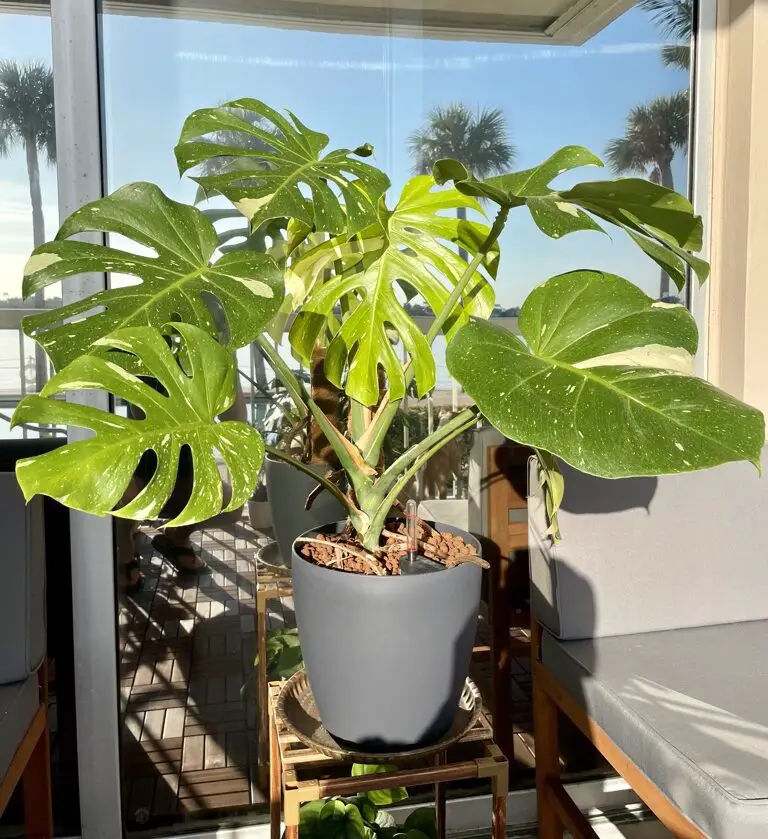Monstera Thai Constellation is a large-leafed, spotted, cream, and green-colored cousin of the traditional monstera deliciosa. It is characterized by cream-colored variegation that comes in patches and spots. The spotted nature of the plants’ variegation inspired the name. Mature foliage displays a star-like constellation of cream spots that make the Monstera Thai Constellation a favorite among houseplant enthusiasts.
Monstera Thai Constellation Care: Plant Monstera Thai Constellation in an airy, well-draining substrate. Place in bright indirect light, and aim for 8+ hours of bright indirect light. Keep temperatures between 55-85F. Allow the top inch or two of soil to dry between waterings.
About Monstera Thai Constellation
Botanical Name: Monstera Deliciosa ‘Thai Constellation’
Common Name: Monstera Thai Constellation, Variegated Thai Monstera
Family: Araceae
Origin: Thailand
If you are lucky enough to have found a Monstera Thai Constellation to bring into your home, providing it with proper care should be high on your list. Although it prefers more light than the non-variegated varieties of monstera deliciosa, it is just as easy to care for. When given proper lighting and water these plants grow large variegated and fenestrated leaves. The inter-nodal spacing is smaller than with the regular Monstera Deliciosa, meaning more leaves will grow from a smaller section of stem.
It is worth noting that the Monstera Thai Constellation grows at a slower rate than its all-green cousin. If you are worried about your plants’ growth rate, provide as much indirect light as possible. It may even be worth investing in a full spectrum grow light to supplement lacking natural light. I personally grow my Thai Constellation in an east-facing window where it gets direct sun in the early morning and bright indirect light for most of the day.

Monstera Thai Constellation Light Requirements
In contrast to their all-green counterparts, Monstera Thai Constellation require more light to reach their full growth potential. It’s important to note that the creme-colored variegation on the Thai Monstera is unable to photosynthesize. The lack of chlorophyll in the variegated portions of the plant is what provides the nice creme color. Chlorophyll is also required in the photosynthesis process, so without it, the plant has less surface area with which to create energy in the form of sugar.
Aim to provide at least 8 hours of bright indirect light per day. The best spot to make this happen is near a south-facing window. If that isn’t an option, a direct spot in an east or west-facing window will do. Your Thai Monstera will appreciate the rays of the sun in the early morning or late evening hours when the light isn’t as harsh. Avoid strong midday sun.
Lighting Tips
Just as with any plant, make sure to acclimate your Monstera to direct sunlight, especially if it is used to a spot where it receives purely indirect light. This can be done by moving it a bit closer to the direct sun over a period of a week or two. If at any point in this process, you notice pale or yellowing on your leaves, or the ends are curling upwards, take the plant a step back and wait a while longer. You don’t want your Thai Monstera sitting in the harsh afternoon sun at any point.

If there isn’t a fitting space to provide the required natural light for this plant, it may be a good idea to invest in a grow light. Grow lights are a great way to supplement a lack of natural light. There are many options for grow lights, some of which have the appearance and hue of a normal light bulb. With such bulbs, you can provide ample light without sacrificing the style of your surrounding space.
When To Water Monstera Thai Constellation
Being an epiphytic, tropical plant, Monstera Thai constellation prefers moist soil. This means watering your plant when the top few inches of its soil are completely dry. You don’t want the entire pot to be bone-dry, but it is also key to avoid wet or soggy soil. I highly recommend a basic moisture meter like this one: https://amzn.to/3kxUWpL, with which you can keep your plant between a 4 to 6 on the moisture scale. This will ensure perfect conditions.
Soggy or wet soil can lead to a lack of oxygen and can become a breeding ground for diseases like root rot. Root rot is one of the most common problems with Thai Monstera. The two biggest things you can do to avoid any issues with root rot or other fungal diseases are not allowing the roots to sit in soggy, overly wet soil. The second is to provide plenty of light. A healthy root system has a much smaller chance of becoming plagued by root rot.

If you are afraid you may over or under water your Monstera Thai Constellation, I highly recommend placing your plant in a self-watering planter with leca or another kind of clay substrate. This way you don’t have to worry about over or under-watering your plant.
I’ve kept my Thai Monstera in leca for years with great success. Just be mindful that clay substrate lacks vitamins, so you will need to periodically supplement your plants’ water with an appropriate fertilizer. I also highly recommend this option if you travel, as you can leave the plants unattended for two to three weeks without any issues.
Humidity Preferences
Average indoor humidity will suit Monstera Thai Constellation just fine. Keeping the humidity above 30% will be sufficient. While keeping it above or near 50% will allow the plant to truly thrive.
One thing to be mindful of in relation to humidity is to not place your Monstera near heaters or AC vents. The dry air coming from these may cause brown leaf edges and crispy spots.
If you notice your plant has brown tips or crispy, brown portions on its foliage, it may be due to a lack of humidity. Check that there aren’t any cold or dry drafts, then check the humidity. A small humidifier should do the trick if you have extremely dry air.
Temperature Requirements
Temperatures between 55-85F will provide the best growing environment for your Thai Monstera. This means most homes will have suitable temperatures for these plants.

Monstera Thai Constellation Growth Rate
Thai Constellation has a slower growth rate than all-green Monstera. But it still has a medium growth rate, you can expect a new leaf every two to three months if the plant is given proper lighting.
The Monstera Thai Constellation often gets a reputation as a slow grower. A common reason for this is that many of these plants do not receive enough light. If you provide 8 or more hours of bright indirect light a day or supplement growing lights for your Monstera, you should observe a moderate speed of growth.
Is Monstera Thai Constellation Toxic?
Yes, Monstera Thai constellation is toxic to dogs and cats. According to the ASPCA (American Society for the Prevention of Cruelty to Animals) Monstera Deliciosa ‘Thai Constellation’ is toxic due to the insoluble calcium oxalates found within their stems and leaves.
Signs of ingestion may include oral irritation, drooling, vomiting, and difficulty swallowing.
If you suspect your pet may have ingested part of this toxic plant. Call or contact your local veterinarian as soon as possible.



